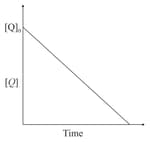EASY
Earn 100
Give the name of the catalyst that used in the contact process.
Important Questions on Chemical Kinetics (AHL)
EASY
HARD
MEDIUM
MEDIUM
| 0.05 | 0.05 | 0.045 |
| 0.10 | 0.05 | 0.090 |
| 0.20 | 0.10 | 0.72 |
EASY
Rate
If the concentration of A is kept the same but that of B is doubled what will happen to the rate itself?
MEDIUM
HARD
EASY
EASY
HARD
the time taken for reaction of is twice the time taken for reaction of . The concentration of varies with reaction time as shown in the figure.The overall order of the reaction is:

EASY
HARD
For an elementary chemical reaction, , the expression for is:
EASY
The initial concentration of is and it is after 30 minutes. The rate of formation of is:
HARD
| Experiment No. | Rate of reaction | |||
The rate of the reaction for and is found to be The value of is __________
MEDIUM
In the following reaction;
‘A’ and ‘B’ respectively can be:
HARD
The results given in the below table were obtained during kinetic studies of the following reaction:
| Experiment | Initial rate/ | ||
| I | |||
| II | |||
| III | |||
| IV | X | ||
| V | Y |
X and Y in the given table are respectively :
MEDIUM
MEDIUM
(i)
(ii)
(iii)
The overall order of the reaction will be
EASY
MEDIUM
Which one of the following statements is correct?

